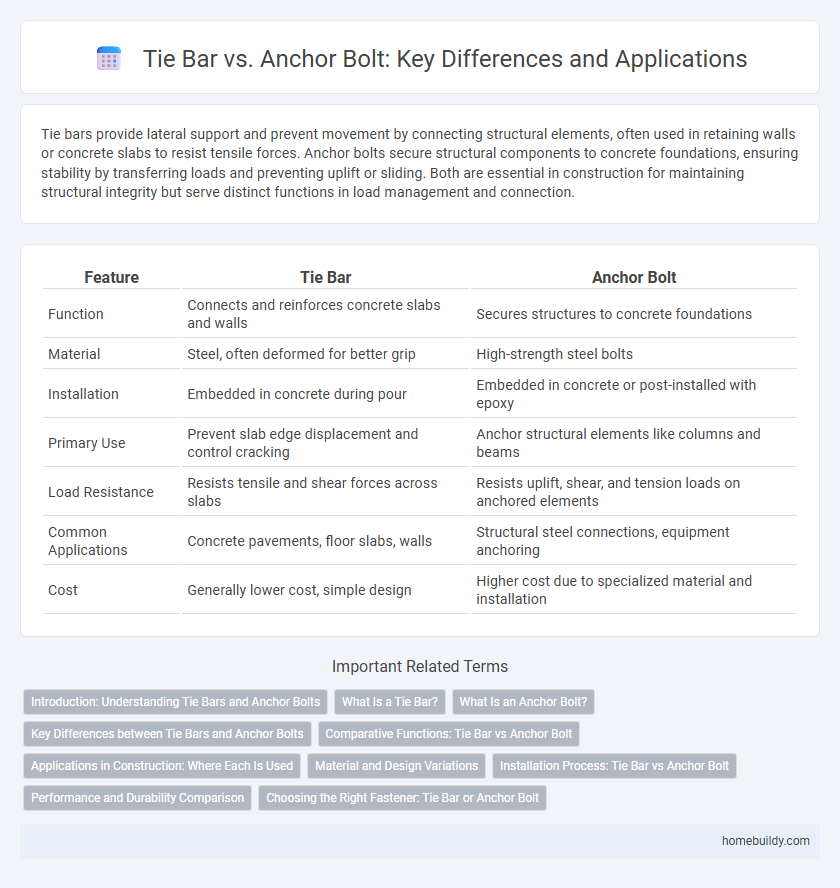Tie bars provide lateral support and prevent movement by connecting structural elements, often used in retaining walls or concrete slabs to resist tensile forces. Anchor bolts secure structural components to concrete foundations, ensuring stability by transferring loads and preventing uplift or sliding. Both are essential in construction for maintaining structural integrity but serve distinct functions in load management and connection.
Table of Comparison
| Feature | Tie Bar | Anchor Bolt |
|---|---|---|
| Function | Connects and reinforces concrete slabs and walls | Secures structures to concrete foundations |
| Material | Steel, often deformed for better grip | High-strength steel bolts |
| Installation | Embedded in concrete during pour | Embedded in concrete or post-installed with epoxy |
| Primary Use | Prevent slab edge displacement and control cracking | Anchor structural elements like columns and beams |
| Load Resistance | Resists tensile and shear forces across slabs | Resists uplift, shear, and tension loads on anchored elements |
| Common Applications | Concrete pavements, floor slabs, walls | Structural steel connections, equipment anchoring |
| Cost | Generally lower cost, simple design | Higher cost due to specialized material and installation |
Introduction: Understanding Tie Bars and Anchor Bolts
Tie bars provide essential lateral support by connecting concrete elements, enhancing structural integrity and preventing cracking. Anchor bolts secure structural components to concrete foundations, ensuring stability under dynamic loads. Both play critical roles in construction, with tie bars focusing on tensile reinforcement and anchor bolts on attachment strength.
What Is a Tie Bar?
A tie bar is a steel reinforcement element used in concrete construction to connect and strengthen separate concrete sections, ensuring structural integrity and preventing cracks caused by shrinkage or tensile forces. Unlike anchor bolts, which secure structural components to concrete foundations, tie bars are embedded horizontally within concrete slabs or beams to maintain alignment and distribute load stresses evenly. The primary function of tie bars is to provide tensile strength and control joint movement, improving durability in pavements and other concrete structures.
What Is an Anchor Bolt?
An anchor bolt is a critical fastener used to secure structural elements to concrete, providing stability and resistance to shear and tension forces. Unlike a tie bar, which connects and reinforces rebar within concrete to control cracking and distribute loads, anchor bolts extend from concrete to attach external components such as steel columns or machinery. Anchor bolts come in various types, including cast-in-place and post-installed, each designed to ensure strong, reliable connections in construction and engineering applications.
Key Differences between Tie Bars and Anchor Bolts
Tie bars primarily function to hold rebar in place within concrete structures, providing reinforcement alignment and tension distribution. Anchor bolts secure structural elements to concrete, offering strong attachment points for machinery, columns, or beams. Unlike anchor bolts designed for load-bearing connections, tie bars are embedded within concrete to maintain rebar stability during pouring and curing.
Comparative Functions: Tie Bar vs Anchor Bolt
Tie bars function primarily to connect and reinforce concrete elements by providing tensile strength along construction joints, enhancing structural integrity. Anchor bolts secure structural components to concrete foundations, resisting shear and uplift forces to maintain stability under dynamic loads. While tie bars improve internal cohesion within concrete structures, anchor bolts ensure external components remain firmly attached to the base.
Applications in Construction: Where Each Is Used
Tie bars are primarily used in reinforced concrete structures to connect and hold concrete slabs or walls together, providing tensile strength and stability in floors, beams, and retaining walls. Anchor bolts are embedded in concrete to secure structural components like steel columns, machinery, or wooden frames, essential for anchoring loads and preventing movement. In construction, tie bars excel in maintaining concrete integrity and load distribution, while anchor bolts are critical for fastening and securing structural elements to foundations.
Material and Design Variations
Tie bars are commonly made from high-strength steel with deformed surfaces to enhance bonding with concrete, whereas anchor bolts typically consist of carbon steel or stainless steel often featuring threaded ends for secure attachments. Tie bars are designed as straight or hooked bars primarily for tensile load transfer within concrete structures, while anchor bolts vary in shape and size to accommodate structural connections and resist different loading conditions. Material coatings such as galvanization or epoxy are frequently applied to both to improve corrosion resistance depending on environmental exposure and design requirements.
Installation Process: Tie Bar vs Anchor Bolt
The installation process of a tie bar involves embedding it into concrete forms before pouring, ensuring a secure connection between concrete slabs or walls by creating mechanical interlock within the concrete mass. Anchor bolts require precise drilling into cured concrete or placement during formwork, followed by tightening nuts to fasten structural components, demanding accurate alignment to avoid structural misfit. Tie bars offer a straightforward embedded connection optimizing load transfer, while anchor bolts provide adjustable post-installation anchorage suited for varied load conditions.
Performance and Durability Comparison
Tie bars offer superior resistance to tensile and shear forces in concrete construction compared to anchor bolts, enhancing structural stability under dynamic loads. Their embedded design minimizes corrosion risk, resulting in greater durability over time, especially in harsh environments. Anchor bolts, while effective for attaching equipment and fixtures, generally exhibit lower load-bearing capacity and increased susceptibility to environmental degradation.
Choosing the Right Fastener: Tie Bar or Anchor Bolt
Selecting the right fastener between a tie bar and an anchor bolt depends on the application's structural requirements and load conditions. Tie bars excel in connecting adjacent concrete slabs to prevent differential settlement, providing lateral load transfer and minimizing slab movement, while anchor bolts are primarily designed to secure structural elements like steel columns and equipment to concrete foundations. Understanding the project's tension and shear forces is crucial for choosing between tie bars for slab reinforcement or anchor bolts for rigid anchorage in construction assemblies.
Tie bar vs Anchor bolt Infographic

 homebuildy.com
homebuildy.com